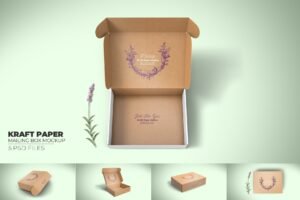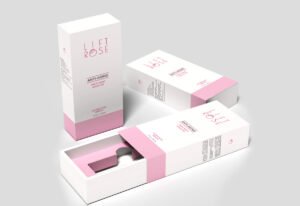Discover how to choose eco friendly packaging for food items, make educated choices, and attract eco-conscious customers.
Have you ever thought that 60% of the plastic used in manufacturing is used to package food items? For a better perspective, of the more than 380 million tons of plastic made in 2015, a staggering 228 million tons were exclusively used to package food items. If you’re working in the food industry and looking to go green, this article will help you choose the best packaging for your food products.

Why Is Eco Friendly Packaging For Food Essential?
The need for eco-friendly packaging in the food industry stems from several compelling reasons. Firstly, traditional packaging often contributes to a significant amount of waste that ends up in landfills or pollutes our environment. Eco-friendly options, on the other hand, are designed to have a lower environmental footprint.
They are made from sustainable materials and are often biodegradable or recyclable, reducing the burden on our ecosystems. Secondly, from a health perspective, some conventional packaging materials may contain harmful chemicals that can leach into the food, posing risks to our well-being. Eco-friendly packaging materials are typically free from such toxins, ensuring the safety and quality of the food they contain.
Moreover, consumers are increasingly demanding environmentally responsible choices. Brands that adopt eco-friendly packaging gain a competitive edge and build a positive reputation among environmentally-conscious consumers.
6 Kinds Of Packaging For Food Products To Think About
Paper Bags That Can Be Recycled
Recycling paper bags offers more than more than just convenient carriers for your groceries. They’re flexible and light, making them ideal for many different food items. From bakery goods to fresh fruits and vegetables, bags created from paper are durable and eco-friendly. The best part is that they’re created with renewable materials such as trees. When they’ve been used and decomposed, they will naturally decay, making them less harmful to the environment. When your clients have had enough and finished, they’re simple to recycle, making them an excellent option for all.
- Paperboard Boxes
Plenty of paperboard containers with snacks, cereals, and other dry goods exist. They’re also sturdy, and they’re also very adjustable, which makes them the perfect option for branding. The best part is that most of them come from sustainably sourced materials, which means you’re doing your part to help the planet.
They’re also recyclable. Eco friendly packaging for food can help decrease waste and keep your items clean and happy for the environment.
- Cans
In the case of preserving cans of vegetables, fruits, and other beverages, the metal cans are among the most underrated heroes. They’re like miniature fortresses, which protect your food items from light, air, and moisture, ensuring the freshness of your food items. They’re also highly recyclable, and a substantial part of them are composed of recycled substances. Therefore, they reduce energy consumption and minimize garbage to a minimal level.
- Glass Jars As Well As Containers
There’s a certain elegance to glass containers and jars. They’re a popular option for keeping the flavor and quality of sauces, jams, and pickles.
What’s more cool? Glass is 100 percent recyclable. That allows it to be recycled indefinitely without losing its qualities. Additionally, it does not release toxic chemical compounds into food products, making Glass an excellent option for your food products and the environment.
- Flexible Pouches
Flexible pouches are useful, lightweight bags that contain cereals, snacks, and powders. They’re compact, which is always an advantage. They’re often manufactured from recyclable materials. This aids in reducing their environmental footprint. Another benefit is that the lighter weight of their shipping contributes to a lower carbon footprint. Therefore, they’re more than just practical but also eco-friendly.
- Edible Films
Here’s something exciting: edible films for custom food packaging. Imagine packaging that you melt in water or eat in your meal! It’s constructed from food-grade materials such as rice paper or seaweed and can be a unique solution to minimize packaging waste. Plus, it adds a unique, eco-friendly dimension to your food products that can catch the eye of environmentally-conscious customers.
Reusable Takeaway Containers
Promoting the reuse of containers manufactured from materials such as bamboo or stainless steel is an environmentally friendly option. Customers can take these custom frozen food boxes back for refills to reduce the amount of single-use packaging.
This is not only environmentally friendly, it also increases customer satisfaction and displays your commitment to sustainability.
Things To Consider When Choosing Eco Friendly Food Packaging For Small Business
For small businesses, cost is an important factor. While eco-friendly packaging may initially have a higher upfront cost, it can lead to savings in the long run through reduced waste disposal costs and potential consumer loyalty.
Availability and supply chain stability are crucial. Ensuring a consistent supply of the chosen packaging is essential to meet business operations.
The packaging should also align with the brand image and marketing strategy. It should communicate the business’s commitment to sustainability and appeal to the target audience.
Why Is Eco Friendly Food Packaging For Restaurants Crucial For Food Products?
For restaurants, eco-friendly packaging is not just about environmental responsibility but also about meeting customer expectations. Customers are more likely to frequent restaurants that demonstrate a commitment to sustainability.
It helps in efficient waste management, reducing the volume of packaging waste generated. This can lead to cost savings and a better reputation in the community.
Also, it can enhance the presentation of takeout and delivery orders, making the food more appealing to customers.
Conclusion
Eco-friendly packaging for food is essential for a sustainable future. The six types of packaging options offer a range of choices to meet different food packaging needs. Small businesses and restaurants need to carefully consider various factors when choosing eco-friendly packaging to balance environmental responsibility with business requirements. By making the right choices, we can all contribute to a healthier planet and a more sustainable food industry.





